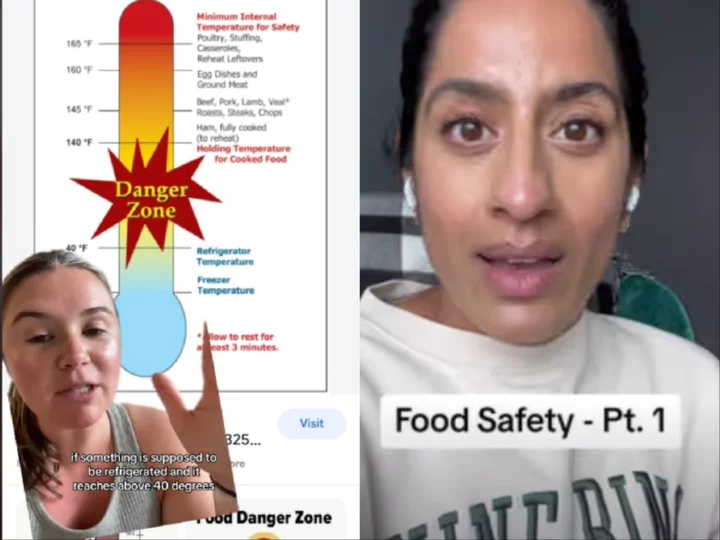
Binge-drinking: 'I was stuck in a cycle of self-destruction'
Three women with experiences of binge-drinking share their stories of completely quitting alcohol.
2023-09-16 14:20

‘Fried rice syndrome’: Dietitians warn against eating food left out at room temperature
Food safety experts have been taking to TikTok to warn against fried rice syndrome and what causes it. Fried rice syndrome is a type of food poisoning which occurs when certain dry foods, such as pasta and rice, contain a bacterium called Bacillus cereus that produces a toxin when heated and left out too long, according to the Centers for Disease Control and Prevention. Concern over the food poisioning has grown recently after reports of 20 year old dying in 2008 from eating five-day-old pasta circulated on TikTok. The concern over the possibility of food poisoning from leftovers has prompted dieticians and other food safety officials to explain what temperatures are and aren’t safe for leftovers. Kyndall Weir is a sports dietician who goes by the username @theathletedietitian on TikTok. In her video, she recalled one of her clients who was eating from the same pizza every week without storing it in the fridge. She then explained why doing something like that can be dangerous by referring to the “temperature danger zone,” which is echoed in the US Department of Agriculture’s Food Safety and Inspection Service’s food safety website. “If something is supposed to be refrigerated and it reaches above 40F degrees, bacteria can start to grow,” Weir explained. “On the other hand, something that is supposed to be hot, like that rice that was cooked, cools down below 140F. That is also in the temperature danger zone.” People had so many questions that the TikToker began a food safety series on her page. One person asked, “Can I heat food up [and] put it directly back in the fridge hot? Bc I heard that’s bad but I do it secretly. BUT I will stop if I should.” Weir responded, “Technically you should let it cool before putting it back in the fridge.” But Weir isn’t the only content creator speaking out about food safety and fried rice syndrome. Dr Shazma Mithani, who goes by the username @drshazmamithani, also posted about the same subject. @theathletedietitian #stitch with @Jpall20 #greenscreen why food safety is so important!!! Im immediately turning this into a series #athletenutrition ♬ Spooky, quiet, scary atmosphere piano songs - Skittlegirl Sound “Do not leave starchy food like rice, pasta, or potatoes out at room temperature,” she warned in the video. “There’s a very specific bacteria that thrives in this environment and produces a toxin that is heat stable, meaning that even when you reheat the food, it does not kill that toxin.” She included more information in the caption, where she clarified that leaving out leftovers longer than they should is usually not a problem, but “starchy foods” can be more prone to the bacteria exposure than other foods. @drshazmamithani Share this to keep your friends and family safe! We are all guilty of letting food sit out for longer than we would like to. Often, it’s not a big deal, but for starchy foods like rice, it’s the perfect breeding ground for a bacteria called Bacillus cereus. This bacteria produces a heat stable toxin that survives even when the rice is reheated. It’s can cause severe vomiting, diarrhea, and dehydration. Please share this and follow for more tips and tricks to keep you and your entire family healthy and out of the ER. . . . . . #foodsafety #food #rice #pasta #potatoes #toxin #bacteria #foodpoisoning #vomiting #diarrhea #er ♬ original sound - Dr. Shazma Mithani, MD, FRCPC According to the USDA, best practices for safely storing hot leftovers is to refrigerate leftovers within two hours of cooking the food or after it is removed from an appliance keeping it warm. After food is safely cooked, hot food must also be kept hot at 140F or warmer to prevent bacterial growth. With cold food, it should be discarded after sitting at room temperature for over two hours, and one hour if it’s been sitting at a temperature above 90F. Read More ‘It can be hard when your kids leave the nest,’ mother says as study finds parents want their children back Sitting this many hours a day ‘rapidly increases’ dementia risk, study warns Woman warns not to ignore symptoms after hot flushes lead to leukaemia diagnosis Schoolboy almost dies from swallowing magnets for TikTok challenge Woman shares honest review of New York City apartment TikTok mom slammed after making 5-year-old son run in 104 degree heat
2023-09-14 04:50

Rising caffeine levels spark calls for ban on energy drink sales to children
By Kailyn Rhone Pediatricians and parents are calling for the U.S. to treat new high-caffeine energy drinks like
2023-08-30 18:56

TikTok viewers spark debate over whether or not to wash chicken - so who’s right?
A TikTok creator’s video sparked debate over whether or not chicken should be washed before it’s cooked. Zoe Barrie (@zoebarrie) posted a video, which has now reached over 3.4m views, on 17 July to reveal her step-by-step process for cooking “spatchcocked roast chicken.” Though the footage was one minute and 23 seconds long, skeptical followers were only concerned with the first 30 seconds: the prep work. Barrie was seen unpackaging a full raw chicken, taking out the guts, and cutting it open. She moved the meat to a wired tray and sprinkled it with salt crystals. Barrie proceeded to place the bird in her fridge before blotting it with a paper towel and searing it in a pan. Immediately, critics flooded the woman’s comment section to question her methods. “Wait, no wash?” one TikTok user asked, while another added: “Um, did you wash it first, though?” “Don’t you rinse before cooking?” one person questioned. Among the suspicious users, kind followers came to Barrie’s defense when they didn’t believe that washing chicken wasn’t necessary. “Washing chicken is as stupid as washing your bread,” one individual wrote. “These washing meat comments are sending me. Y’all are so silly,” another woman remarked. Despite the overwhelming number of individuals who argued raw poultry needs to be rinsed, the Food Safety and Inspection Service (FSIS) advises against it. The FSIS warned that washing chicken leads to the spread and cross-contamination of bacteria and “poultry juices” onto other food and surfaces. Water also won’t “destroy” bacteria like Salmonella or Campylobacter, and “only cooking will destroy any bacteria that might be present on fresh chicken.” @zoebarrie spatchcocked roast chicken ftw 😤 (crispy chicken ib cooking school and samin nosrat & lemon chimichurri ib me) #roastchicken #salt ♬ Wes Anderson-esque Cute Acoustic - Kenji Ueda Cross-contamination increases the risk of food poisoning, according to the FSIS. “This can occur if raw poultry or its juices come in contact with cooked food or foods that will be eaten raw, such as salad,” the report read. Per the 2019 Food Safety Consumer Research Project analysis, individuals who washed their chicken in the sink were more likely to contaminate their produce due to the bacteria left on the surface. The Minnesota Department of Health noted that, even if you wash chicken in a “slow stream of water,” risky germs are still able to splash on to fresh food or other dishes. Although most reports advise against soaking or rinsing poultry, some people still prefer to do so. In this case, the Centers for Disease Control and Prevention put together a list of recommendations for how to safely clean the raw food. First, chefs shoud “run the water gently over the chicken to reduce splashing”. Then, immediately clean the sink and area around the sink with hot soapy water and sanitise it thoroughly. After handling raw poultry, people should also wash their hands for 20 seconds. Barrie went on to let the chicken brown in a pan and bake in the oven. Finally, she garnished the meat with a chimichurri-like spread. The Independent has reached out to Barrie for a comment. Read More Child wiping their hands on wedding dress sparks debate in viral TikTok People are surprisingly divided over burrata as debate oozes online Woman claims restaurant ‘hack’ for toddlers solves family dinners out
2023-08-02 00:52

US FDA reviewing concerns over Logan Paul's PRIME energy drink
The U.S. Food and Drug Administration said on Wednesday it is reviewing concerns raised by Senate Majority Leader
2023-07-13 07:25

Nutritionist explains how women can eat to help balance hormones
Some healthy eating principles apply to just about everyone – drinking enough water and consuming plenty of fresh fruit and veg, for example. But when it comes to hormones, a lot of diet advice neglects to mention the vast difference between women’s and men’s health. “Women are very under-represented in research, mainly because we have a menstrual cycle,” says functional nutritionist and author Pauline Cox. “My passion and mission is to empower women with the information and knowledge that can radically change their immediate health and their long-term health.” Cox, 43, who started her career as a physiotherapist before becoming a nutritionist, now mainly works with groups of women online and has just released her second book, Hungry Woman: Eating for Good Health, Happiness and Hormones. “I felt there was a lot of information that could be shared with women to help them understand their hormones, and understand that we don’t have to get frustrated with ourselves and fight our female physiology.” At the heart of the issue is the balance (or lack thereof) between oestrogen and progesterone levels. “When our progesterone levels are low, our oestrogen can become dominant, and that’s when we start to see things like PMS, heavy periods, painful periods, flooding at the beginning of our periods,” says Cox, who lives in Somerset. “A lot o women accept that as part of their monthly cycle, but when we bring our progesterone levels back up, it helps to balance the effect of oestrogen.” Here, she explains five ways women can tailor their diets to keep their hormones in check… 1. Look after your liver “Oestrogen is a driving-growth hormone,” Cox explains, using the analogy of grass growing on a lawn to explain how the two hormones interact. “Progesterone is like the lawnmower. It comes along and it keeps the grass in check. When we lose progesterone, oestrogen gets out of control.” That’s why it’s important that our bodies are able to clear oestrogen efficiently through the liver, gut and bowels. “How much oestrogen we clear can be influenced by what we eat and how we live,” says Cox. “There’s a lot of cruciferous in the book – cauliflower, broccoli, these are really great vegetables to support liver detoxification.” 2. Add fermented foods To deliver beneficial bacteria to your gut, try including fermented foods like pickled vegetables, kefir, kombucha or natural yoghurt as part of your daily diet. “Our gut diversity declines as we age and microbiome diversity has been linked with longevity and good health,” says Cox, who suggests just a tablespoon of sauerkraut a day can make a difference. “These are easy wins…to maximise our longevity and optimise our gut-brain axis, which is incredibly important.” 3. Avoid ultra-processed foods There’s been a lot of talk recently about how detrimental ultra-processed foods are, and that includes the effect on hormone levels. “When we’re eating high sugar, processed foods, our inflammatory levels go up and our cortisol level goes up, which robs us of progesterone,” Cox says. Plus, filling up with these empty calories – as delicious as they often are – means we have less room for nutritious foods. “They can often be devoid of nutrients, so you’re not getting the nutrients you need for building hormones and supporting hormonal health like magnesium, zinc, B vitamins, and omega three fatty acids.” 4. Create an eating window It’s not just what you eat, it’s when. Cox recommends having an ‘eating window’ during the day that ends around 6pm, so that there’s a gap of a few hours before you go to bed. “When your blood sugars go up at night, your kidneys have to kick in to try and remove this excess blood sugar, which then means you’re up in the night urinating,” she says. “A lot of women associate this with drinking a lot before bed, but actually eating late at night can also be for that reason.” Choosing meals that are nutritious and satisfying is the next step. “Within that window, start becoming a bit more conscious of your carbs and upping your protein,” she continues. “So you’re feeling full, your body’s getting all the amino acids it needs, and you’re maybe not having so much of the grab-and-go food like the sandwiches, the pasta, the crisps.” 5. Monitor your magnesium “Most women are sub-clinically deficient in magnesium,” Cox explains, which can cause insomnia, and the risk increases with age. “As we get to about the age of 40, we absorb less magnesium than we would have in our 20s.” Diet also plays a role: “If we have high blood sugars and levels of inflammation when we’re stressed, we lose magnesium.” She recommends taking a magnesium glycinate or bisglycinate supplement before bed to increase your chance of getting a good night’s sleep. “The glycine part of that helps to reduce your core body temperature, which is what the body wants when it’s going to bed,” she says. “That compound also helps get you into what’s called REM sleep, which is the sleep where you’re consolidating memories and learning.” Hungry Woman by Pauline Cox is published by Ebury Press, priced £27. Photography by Luke Albert. Available Now. Read More From hairdressers to aloe vera: What will Diet Coke join as a ‘possible cancer risk’ Charity boss speaks out over ‘traumatic’ encounter with royal aide Ukraine war’s heaviest fight rages in east - follow live
2023-06-30 22:53

Biden admits using sleep apnoea treatment device
The president uses a CPAP machine, the White House said after reporters spotted marks on his face.
2023-06-29 07:50

Americans are drinking alcohol at levels not seen since the Civil War, report says
As if 2023 wasn’t hard enough, Americans are now drinking as much alcohol as they did during the Civil War days. A new report from the National Institute on Alcohol Abuse and Alcoholism (NIAAA) has found that the average American drinks about the same amount of alcohol as people did in 1860. In 2021, Americans consumed 2.51 gallons of ethanol – the alcohol found in wine, beer, and spirits – compared to 2.53 gallons at the brink of the Civil War. That amount, which doesn’t include water or other ingredients found in alcoholic beverages, marks a 60 per cent increase in liquor consumption compared to the mid-1990s. Americans have also changed their taste for alcohol. The amount of beer consumed has dropped nearly 20 per cent since 1995, while wine has steadily become America’s drink of choice. Now, 50 per cent more Americans are drinking wine than they did in the mid-1990s. This isn’t the only time the United States has seen staggering levels of alcohol consumption. In 1934, following the repeal of the Prohibition Act, Americans were drinking one gallon of ethanol per person. At the end of World War II in 1945, Americans reached 2.3 gallons. This, compared to 2.8 gallons in 1980, when alcohol consumption was at its highest. The rise in alcohol consumption may also have to do with a key demographic: women. In March, it was revealed that women in the US are out-drinking men for the first time in history. Dr George Koob, director of the NIAAA, recently told the Washington Examiner that binge drinking among college students are to blame. “In 2021, there has been an uptick, particularly among women. Now it turns out on college campuses women are actually binge drinking more than men, for the first time in history,” he told the conservative media outlet. The Covid-19 pandemic also saw a dramatic shift in alcohol consumption, as most states declared liquor stores were considered “essential businesses”. In 2020, the first year of the pandemic, sales of alcohol increased by 2.9 per cent, the biggest annual increase in more than 50 years, according to the NIAAA. Now, with college campuses back in session and local bars open again, Koob attributed the rising trend of women binge drinking to the “alcohol deprivation effect” – in which people “rebound in drinking” after a period of abstaining from alcohol. “A standard drink is 1.5 ounces of vodka, 12 ounces of beer, or five ounces of wine,” he said. “When you go past a standard drink, you really are getting to the point where alcohol ultimately becomes a toxin. You can easily overdose.” The Centers for Disease Control and Prevention (CDC) says that it’s safe for women to drink no more than one standard alcoholic beverage a day, and no more than two for men. However, binge drinking usually corresponds to five or more drinks on a single occasion for men, while four or more drinks on a single occasion for women. Read More Moderate alcohol consumption may lower stress, reduce heart disease risk, study finds Man dies after eating raw oysters from Missouri seafood stand Hip surgery policies based on weight ‘worsen health inequality’, study warns TikToker cooks rack of ribs in hotel bathroom using only items from his room BBQ salad recipes without a soggy lettuce leaf in sight How to shop for and cook Japanese food at home like a pro
2023-06-14 08:19
